A 1965 radio interview held in the collection of Sound Archives Ngā Taonga Kōrero has shed light on the home-baking sent by New Zealand women to our soldiers during World War I, and the incredible baking and fund-raising efforts of one woman in particular.
On Gallipoli, food parcels from home must have been one of the few bright points in the Anzac soldier’s generally abysmal diet, which largely consisted of fatty, salty, tinned “bully beef” and rock-hard ship’s biscuits.
New Zealand families and the Red Cross organised parcels containing tinned luxuries such as condensed milk, coffee and cocoa, as well as home-made biscuits and sweets. Most famous of course, is the Anzac biscuit, and with the centenary of the 1915 Gallipoli landings fast approaching, the debate over its origins seems set to rival the Great Pavlova Debate .
Food historians on both sides of the Tasman have been delving into vintage recipe books in a bid to see whether Australia or New Zealand can claim to be the originator of the rolled oat and golden syrup concoction: http://www.stuff.co.nz/life-style/food-wine/9668401/Battle-of-the-Anzac-biscuit
(For the record, New Zealand is ahead in the race, with a cookbook published in 1919 featuring a recipe for “Anzac Crispies,” two years before Australia’s earliest entry in a 1921 cookbook.)
But whether it was baked first in a kitchen in Kerikeri or Coolangatta, the Anzac biscuit as we know it was most likely too fragile and perishable to last the long sea voyage to the distant Dardanelles. Instead, it is believed its name came from marketing-savvy home-bakers, who attached the name “Anzac” to their oaty biscuits to promote sales at Red Cross fundraising stalls, sometime after the 1915 landings.
One home-baked treat which was actually enjoyed by soldiers in the trenches from Gallipoli to the Western Front, was the gingernut biscuit – and most likely it was baked to a recipe made famous by a Taranaki woman, Helena Marion Barnard, who received the British Empire Medal for her efforts.
Mrs Barnard, originally from Nelson, was living in Eltham with her husband, daughter and eight sons when World War I broke out in August 1914. Six of her boys were to serve in that war, three of them on Gallipoli. Two of them were to die in the conflict, with the other four suffering illness, shell shock or serious wounds.
In this recorded interview made at the time of her 100th birthday in 1965, Mrs Barnard talks about how she first started making gingernut biscuits prior to the war, for her sons to take tramping, or “pioneering,” as she puts it.
[Listen to the audio on the Sound Archives blog here – http://filmarchive.org.nz.customer.modicagroup.com/blog/nz-history/was-the-real-anzac-biscuit-a-gingernut/]
Interview with Helena Marion Barnard, 1965.
[Archival audio from Sound Archives Ngā Taonga Kōrero. Any re-use of this audio is a breach of Copyright. To request a copy of the recording, contact SANTK.]
![Helen Marion Barnard in April 1965, on her 100th birthday, with her surviving sons, Frank, Jim and Joe. [photo courtesy of Winsome Griffin]](https://i0.wp.com/filmarchive.org.nz.customer.modicagroup.com/blog/wp-content/uploads/2014/05/Mrs-Barnard1.jpg)
Helen Marion Barnard in April 1965, on her 100th birthday, with her surviving sons, Frank, Jim and Joe. [photo courtesy of Winsome Griffin]
With the advent of World War I, she again baked the long-lasting biscuits and packed them into tins to send to her sons and other soldiers overseas. Her biscuits were unusually small – about the size of a shilling, so the men could fit a handful in their pockets. She says she packed them into cocoa or golden syrup tins lined with newspapers, so the boys would have some reading material as well, while they ate.
Throughout World War I, Mrs Barnard baked hundreds of pounds of the treats which were distributed to New Zealand and other Empire soldiers through the Red Cross. As well as baking, she knitted socks and balaclavas for the troops and raised money to buy a motor-ambulance for the Army.
An article from the local newspaper in 1916, gives some insight into how the women of the Eltham district were raising money for the ambulance, and the sort of foods and other “comforts” they were sending to their boys, including “Mrs H.J. Barnard 15 lbs home-made gingernuts, 4 pairs mittens.”
![["Hawera and Normanby Star," 17 August 1916. Reproduced courtesy of Papers Past, National Library of New Zealand.]](https://i0.wp.com/filmarchive.org.nz.customer.modicagroup.com/blog/wp-content/uploads/2014/05/MrsBarnard2.jpg)
[“Hawera and Normanby Star,” 17 August 1916. Reproduced courtesy of Papers Past, National Library of New Zealand.]
After the war, Mrs Barnard purchased a bell for Wellington’s National War Memorial Carillon, which was erected in Buckle Street in 1932. She had the bell named “Suvla Bay” and dedicated it to her two lost boys:
http://www.mch.govt.nz/files/National%20War%20Memorial%20Bells%201932%20%28D-0501286%29.PDF
In recognition of their war-time fundraising and baking efforts Mr and Mrs Barnard were presented with this beautifully illuminated scroll by the citizens of Eltham, when the family moved away from the district.
![[Reproduced courtesy of Winsome Griffin]](https://i0.wp.com/filmarchive.org.nz.customer.modicagroup.com/blog/wp-content/uploads/2014/05/MrsBarnard3.jpg)
[Reproduced courtesy of Winsome Griffin]
It features photographs of Mr and Mrs Barnard in the centre, the motor ambulance at the bottom and her six sons who served in WWI around the frame, including the two who were lost: Henry, at top right and Charles, bottom left.
When World War II started in 1939, 80 year old Mrs Barnard was a widow, living in Island Bay in Wellington. With two sons as well as grandchildren now serving overseas, she once again tied on her apron. Food rationing meant it was hard for her to obtain the enormous quantities of butter and sugar needed. However, she managed to get a special permit from the Food Controller for extra rations and went on to make nearly a million gingernuts during the five years of this war, which she once again sent to New Zealand and other Allied troops overseas.
Mrs Barnard ended her baking career having made an astounding four and a half tons of gingernut biscuits in total. She was awarded the British Empire Medal and received thank-you letters from grateful service-men and their mothers, all over the world. The letters found their way to her often simply addressed to: “Mrs Barnard, The Gingernut Maker, Wellington, New Zealand.”
One which was published in the local newspaper, contained the thanks of a WWII midshipman, Peter S. Burns of the Merchant Navy: ”… allow me to assure you when I am freezing to death standing on the bridge… in the middle of the Atlantic and whenever my hand goes frantically into my coat pocket to get a gingernut, my thoughts go to the kind person from whom I received them.”
As you hear in the interview, Mrs Barnard was fond of sharing her recipe. Throughout both wars, she built up a correspondence with other soldiers’ mothers, sharing the recipe and samples of her biscuits. In the spirit of this, Sound Archives Ngā Taonga Kōrero cataloguer Camilla Wheeler and client supply archivist Sarah Johnston have been baking Mrs Barnard’s recipe. Camilla converted the large quantities into proportions more manageable for modern bakers (the original recipe calls for 2 ¼ pounds of flour and 2 pounds of golden syrup!) and they have experimented with different methods and baking times.
Sound Archives staff have been taste-testing the results over the past few weeks and are happy to report the 100-year old recipe withstood conversion very well, producing a very tasty, dense, chewy biscuit which keeps well and is perfect for dunking in a cup of tea.
You can read Mrs Barnard’s original recipe and our modern conversions here.
Thank you to Barnard family researchers Winsome Griffin, Christine Clement and Louise Mercuri for permission to reproduce material from their websites:
http://winsomegriffin.com/Barnard/HelenaMarionBarnard.html
http://freepages.genealogy.rootsweb.ancestry.com/~sooty/barnard.htm


Some of SANTK’s batches of gingernuts – both Mrs Barnard-sized and regular-sized.
 I came to PHM through a short placement with the IF volunteer programme and what was six weeks has turned into six months. During that time I’ve been working with another volunteer, John, and Catherine, Kirsty, Harriet and Mark from different departments of the museum to develop an object handling table. Although object handling may become a permanent feature, during the WWI centenary it made sense to concentrate on objects from that period.
I came to PHM through a short placement with the IF volunteer programme and what was six weeks has turned into six months. During that time I’ve been working with another volunteer, John, and Catherine, Kirsty, Harriet and Mark from different departments of the museum to develop an object handling table. Although object handling may become a permanent feature, during the WWI centenary it made sense to concentrate on objects from that period. Arranging objects on the table was another thing I experimented with. Visitors aren’t too interested in looking at photographs and leaflets but wander towards medals and feathers. I found placing the less visually appealing items in the middle of the shiny things means eyes wander over them more often and visitors are more likely to eventually pick them up. Also, objects like ration books are easily ripped by little hands so the rule is tougher items at the front and more delicate ones at the back near the handler. Putting the solder’s hat and badge on an information sheet meant visitors had to pick up the hat to read the information and if they’ve picked up one object, they tend to pick up a few more. Crafty.
Arranging objects on the table was another thing I experimented with. Visitors aren’t too interested in looking at photographs and leaflets but wander towards medals and feathers. I found placing the less visually appealing items in the middle of the shiny things means eyes wander over them more often and visitors are more likely to eventually pick them up. Also, objects like ration books are easily ripped by little hands so the rule is tougher items at the front and more delicate ones at the back near the handler. Putting the solder’s hat and badge on an information sheet meant visitors had to pick up the hat to read the information and if they’ve picked up one object, they tend to pick up a few more. Crafty.













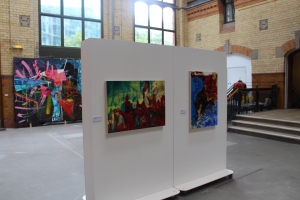
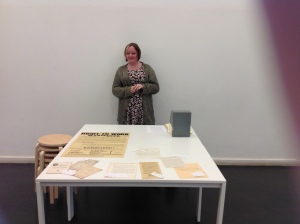
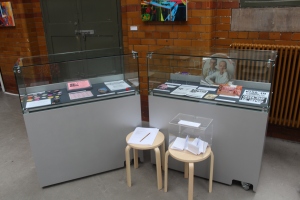
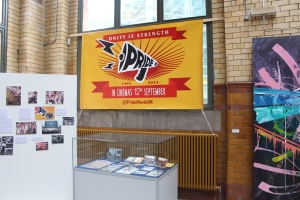
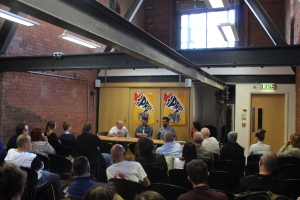

![Helen Marion Barnard in April 1965, on her 100th birthday, with her surviving sons, Frank, Jim and Joe. [photo courtesy of Winsome Griffin]](https://i0.wp.com/filmarchive.org.nz.customer.modicagroup.com/blog/wp-content/uploads/2014/05/Mrs-Barnard1.jpg)
![["Hawera and Normanby Star," 17 August 1916. Reproduced courtesy of Papers Past, National Library of New Zealand.]](https://i0.wp.com/filmarchive.org.nz.customer.modicagroup.com/blog/wp-content/uploads/2014/05/MrsBarnard2.jpg)
![[Reproduced courtesy of Winsome Griffin]](https://i0.wp.com/filmarchive.org.nz.customer.modicagroup.com/blog/wp-content/uploads/2014/05/MrsBarnard3.jpg)






 Shortly before war was declared on 4 August 1914 the Labour MP Keir Hardie led an anti-war protest at Trafalgar Square attended by several thousand of people. There was little interest for war in the weeks leading up to the declaration. Yet after war was declared Hardie’s anti-war stance was reviled and his speeches met with heckling as the country came together in support for the war effort.
Shortly before war was declared on 4 August 1914 the Labour MP Keir Hardie led an anti-war protest at Trafalgar Square attended by several thousand of people. There was little interest for war in the weeks leading up to the declaration. Yet after war was declared Hardie’s anti-war stance was reviled and his speeches met with heckling as the country came together in support for the war effort. especially from people who had just lost relatives at the front. Indeed many volunteers were motivated by the sense that if men were needed to win the war, why should they stay, while others fought for them? Clement Attlee, future Labour leader, reflected in his memoirs that ‘it appeared wrong to me to let others make a sacrifice while I stood by.’
especially from people who had just lost relatives at the front. Indeed many volunteers were motivated by the sense that if men were needed to win the war, why should they stay, while others fought for them? Clement Attlee, future Labour leader, reflected in his memoirs that ‘it appeared wrong to me to let others make a sacrifice while I stood by.’


